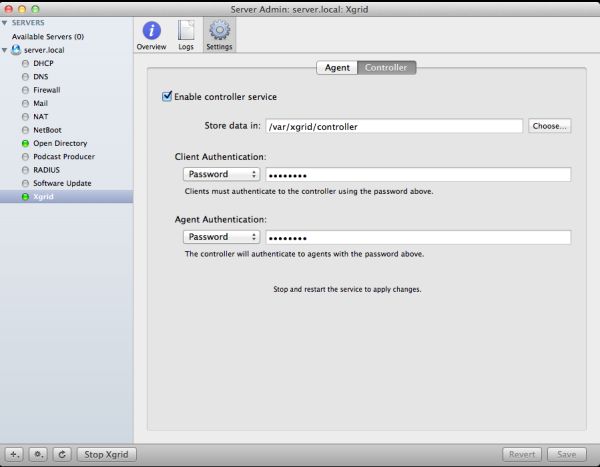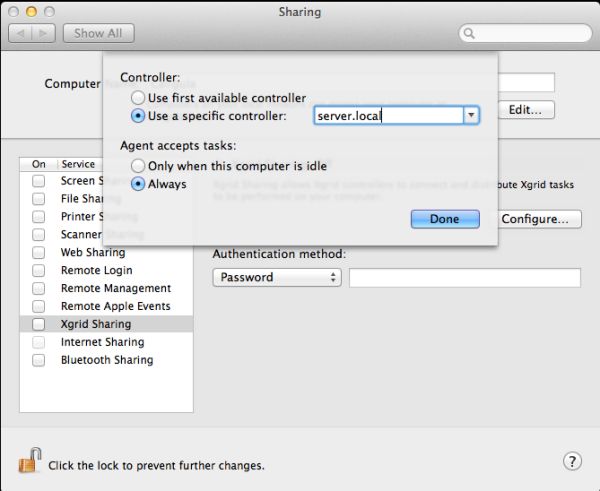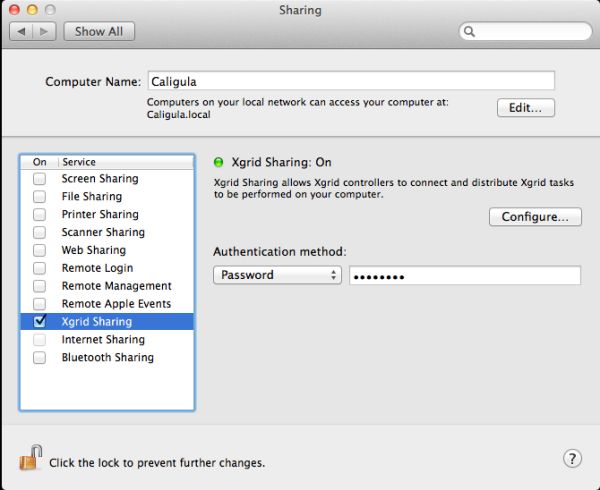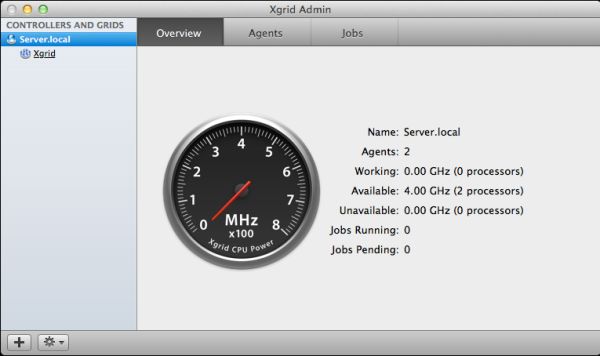In-Depth with Mac OS X Lion Server
by Andrew Cunningham on August 2, 2011 8:00 AM ESTXgrid is the last of the services we'll be looking at tonight, and it's not a new one so we won't spend too much time here. Accessible only via Server Admin, Xgrid is Apple's distributed computing service - basically, it allows many computers to process a single task, thus completing that task exponentially more quickly than any one computer could do alone.
Configuring the service is easy - just select the service in Server Admin, click the Configure Xgrid Service button, elect to create an Xgrid Host, input your Directory Administrator credentials, and you're done.
You can control how clients authenticate to your Xgrid in the Controller tab within the Settings tab. For convenience's sake, I'll just have my clients authenticate with a simple password. By the same token, you can make your server's CPU cycles available to Xgrid in the Agent tab.
Now, to get other computers in on the fun, go to the Sharing System Preference pane, go to Xgrid Sharing, and click Configure. Tell your computer to use a specific controller, and input your server name.
Under Authentication method, make sure what you put here matches the setting you put in on the server, and then check the service's checkbox to start it up.
Now, check to see that everything is working using the Xgrid Admin Server Admin Tool - if you've configured your computers correctly, you should see that a pool of CPUs are available for your use.
Your Xgrid clients can now submit jobs via the command line, and you can use Xgrid Server to start, stop, pause, and dictate the priority of those jobs.
The actual use of Xgrid is a little outside the scope of this review, but sadly it's one of those things that sounds a lot cooler in theory than it is in practice. You can't really use Xgrid to speed up consumer applications from Apple or Adobe - it's best used to help with CPU-intensive calculations, and it's not even ideal for all of those. If you're interested in learning more (and if you're fairly technically literate), I'll point you toward the generally excellent Xgrid wiki and wish you luck.














77 Comments
View All Comments
Kristian Vättö - Tuesday, August 2, 2011 - link
Your Twitter was right, this really is endlessCharonPDX - Tuesday, August 2, 2011 - link
It was that pesky loop that started on page 23 that circled you back to page 8. By the time you'd read page 23, you'd forgotten what was on page 8, so you didn't notice you were in a loop until you were at what you thought was page 157...B3an - Tuesday, August 2, 2011 - link
Very in depth article... but i feel you've wasted time on this. No one in there right mind would use OSX as a server. Apart from Apple fanboys that choose an inferior product over better alternatives because it has an Apple logo, but i emphasize the words "right mind".FATCamaro - Tuesday, August 2, 2011 - link
For enterprise work, or a Windows-only network this is certainly true. For SMB, or even 500 mac/mixed users I think it could work if you can provide some glue to handle fail-over.Windows server is better for Office for sure as is Linux for web & applications.
Spivonious - Wednesday, August 3, 2011 - link
I can run a web server on the client version of Windows. It's just not installed by default.mino - Saturday, August 6, 2011 - link
Hint: for how many users/connections ....If it was THAT simple there would be no Web Edition, mind you.
AlBanting - Friday, August 19, 2011 - link
Same thing for client version of Mac OS X. I've done this for years.KPOM - Tuesday, August 2, 2011 - link
True, for an enterprise user. However, a small business or tech-savvy home user trying to manage multiple Windows PCs, Macs, and iOS devices might well be tempted by the $50 price tag.If should be obvious by the price drop and the discontinuation of the XServe that Apple no longer intends to compete with Windows Server or Linux in the enterprise market. They are a consumer-oriented company, and released a server OS intended for a consumer market.
zorxd - Tuesday, August 2, 2011 - link
Tech-savvy home user will run a free linux distro for a server. Plus it will work on any hardware, not only on a Mac. Many use older PCs as servers.Also the Mac Pro is too expensive and the Mac Mini can't even have 3.5" drives which mean that it is a bad solution for a file server.
richardr - Tuesday, August 2, 2011 - link
Actually, I have a real use case, though it may be a bit specialised for your tastes... non-computing departments of universities are full of people with underused desktops running Word, but also have other people doing analyses that take ages to run on their machines. Making them all Macs (you'll never persuade them to use linux) and wiring them up with xgrid and OSX Server is a pretty pain-free way of running my analyses on their machines without too much disruption to their lives...